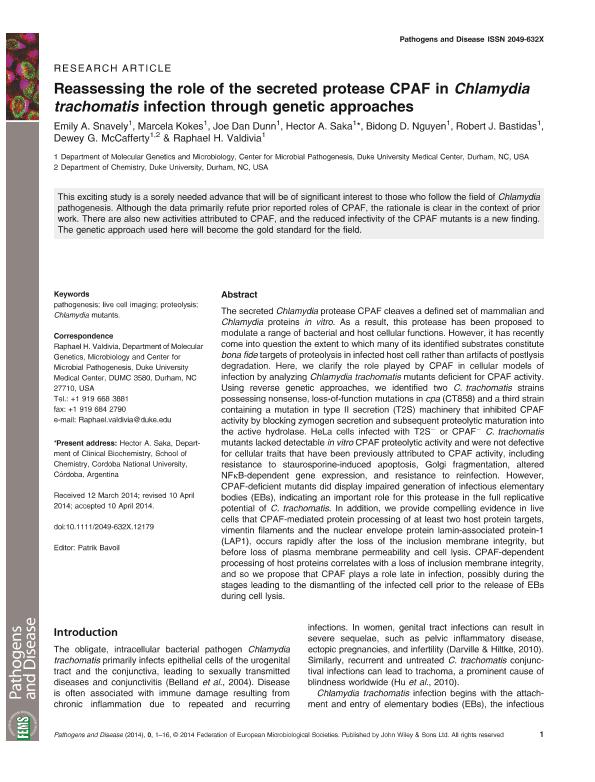Mostrar el registro sencillo del ítem
dc.contributor.author
Snavely, Emily
dc.contributor.author
Kokes, Marcela
dc.contributor.author
Dunn, Joe Dan
dc.contributor.author
Saka, Hector Alex

dc.contributor.author
Nguyen, Bidong D.
dc.contributor.author
Bastidas, Robert J.
dc.contributor.author
McCafferty, Dewey G.
dc.contributor.author
Valdivia, Raphael H.
dc.date.available
2018-01-22T15:49:14Z
dc.date.issued
2014-05
dc.identifier.citation
Snavely, Emily; Kokes, Marcela; Dunn, Joe Dan; Saka, Hector Alex; Nguyen, Bidong D.; et al.; Reassessing the role of the secreted protease CPAF in Chlamydia trachomatis infection through genetic approaches; John Wiley & Sons; Pathogens and disease; 71; 3; 5-2014; 336-351
dc.identifier.issn
2049-632X
dc.identifier.uri
http://hdl.handle.net/11336/34085
dc.description.abstract
The secreted Chlamydia protease CPAF cleaves a defined set of mammalian and Chlamydia proteins in vitro. As a result, this protease has been proposed to modulate a range of bacterial and host cellular functions. However, it has recently come into question the extent to which many of its identified substrates constitute bona fide targets of proteolysis in infected host cell rather than artifacts of postlysis degradation. Here, we clarify the role played by CPAF in cellular models of infection by analyzing Chlamydia trachomatis mutants deficient for CPAF activity. Using reverse genetic approaches, we identified two C. trachomatis strains possessing nonsense, loss of function mutations in cpa (CT858) and a third strain containing a mutation in type II secretion (T2S) machinery that inhibited CPAF activity by blocking zymogen secretion and subsequent proteolytic maturation into the active hydrolase. HeLa cells infected with T2S− or CPAF−C. trachomatis mutants lacked detectable in vitro CPAF proteolytic activity and were not defective for cellular traits that have been previously attributed to CPAF activity, including resistance to staurosporine induced apoptosis, Golgi fragmentation, altered NFκB dependent gene expression, and resistance to reinfection. However, CPAF deficient mutants did display impaired generation of infectious elementary bodies (EBs), indicating an important role for this protease in the full replicative potential of C. trachomatis. In addition, we provide compelling evidence in live cells that CPAF mediated protein processing of at least two host protein targets, vimentin filaments and the nuclear envelope protein lamin associated protein 1 (LAP1), occurs rapidly after the loss of the inclusion membrane integrity, but before loss of plasma membrane permeability and cell lysis. CPAF dependent processing of host proteins correlates with a loss of inclusion membrane integrity, and so we propose that CPAF plays a role late in infection, possibly during the stages leading to the dismantling of the infected cell prior to the release of EBs during cell lysis.
dc.format
application/pdf
dc.language.iso
eng
dc.publisher
John Wiley & Sons
dc.rights
info:eu-repo/semantics/openAccess
dc.rights.uri
https://creativecommons.org/licenses/by-nc-sa/2.5/ar/
dc.subject
Pathogenesis
dc.subject
Live Cell Imaging
dc.subject
Proteolysis
dc.subject
Chlamydia Mutants
dc.subject.classification
Otras Ciencias Biológicas

dc.subject.classification
Ciencias Biológicas

dc.subject.classification
CIENCIAS NATURALES Y EXACTAS

dc.title
Reassessing the role of the secreted protease CPAF in Chlamydia trachomatis infection through genetic approaches
dc.type
info:eu-repo/semantics/article
dc.type
info:ar-repo/semantics/artículo
dc.type
info:eu-repo/semantics/publishedVersion
dc.date.updated
2018-01-22T14:17:31Z
dc.journal.volume
71
dc.journal.number
3
dc.journal.pagination
336-351
dc.journal.pais
Estados Unidos

dc.journal.ciudad
Malden
dc.description.fil
Fil: Snavely, Emily. University of Duke; Estados Unidos
dc.description.fil
Fil: Kokes, Marcela. University of Duke; Estados Unidos
dc.description.fil
Fil: Dunn, Joe Dan. University of Duke; Estados Unidos
dc.description.fil
Fil: Saka, Hector Alex. Consejo Nacional de Investigaciones Científicas y Técnicas; Argentina. University of Duke; Estados Unidos
dc.description.fil
Fil: Nguyen, Bidong D.. University of Duke; Estados Unidos
dc.description.fil
Fil: Bastidas, Robert J.. University of Duke; Estados Unidos
dc.description.fil
Fil: McCafferty, Dewey G.. University of Duke; Estados Unidos
dc.description.fil
Fil: Valdivia, Raphael H.. University of Duke; Estados Unidos
dc.journal.title
Pathogens and disease
dc.relation.alternativeid
info:eu-repo/semantics/altIdentifier/doi/http://dx.doi.org/10.1111/2049-632X.12179
dc.relation.alternativeid
info:eu-repo/semantics/altIdentifier/url/https://academic.oup.com/femspd/article/71/3/336/476044
Archivos asociados
